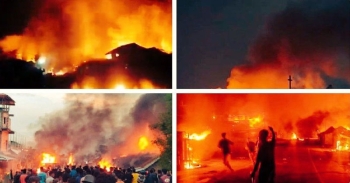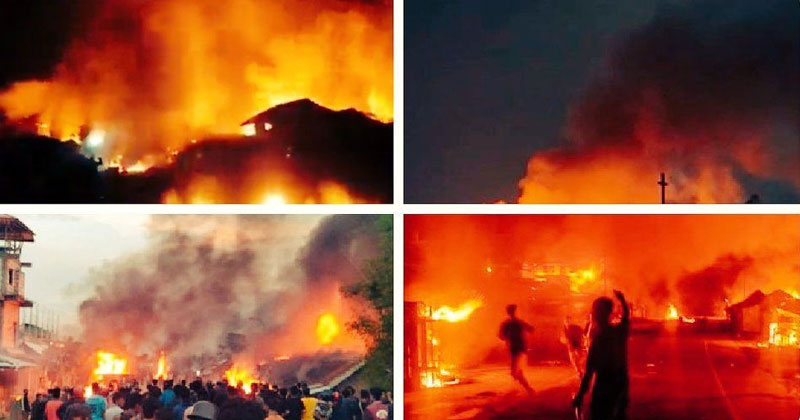
.png) Albert Thyrniang
Albert Thyrniang

The images and footages emanating from Manipur reveal the shocking turns of events in the North Eastern state. The scenes of hundreds of charred vehicles, the flames and smoke in the skies, the looting, the destroyed churches, the fleeing crowds reveal the kind of mayhem that went on for four to five days. The most appalling are that videos of people being beaten mercilessly (even to death) by rival mobs. The sense of humanity vanished.
Even though those who escaped the violence recount their horrors the quantum of violence may never be comprehended. The scale of destruction is immeasurable. That barbaric acts should take place in the 21st century is unpardonable. The seriousness of the situation was so grave that the Centre had to commission the central forces. The latest official counts are 60 deaths, 231 injured and 1,700 houses destroyed and thousands have turned refugees in their own state in cramped relief camps with minimum privacy. An unprecedented human crisis!
While Manipur burned, the Prime Minister was totally unperturbed. He was too obsessed with the elections in Karnataka to be concerned with the communal clashes that engulfed the state. He instead invoked ‘The Kerala Story’, a movie that depicts terror conspiracies, to accuse the Congress of playing vote bank politics. ‘The Gujarat Story’ should also be made to set the record straight.
The PM’s silence was intentional. The BJP is ruling Manipur. To even say that any form of violence is unacceptable might be seen as a criticism of the state government. But the actual reason could be something else. It is fair to say that the minority is more at the receiving end in the Manipur riots. The majority should not be offended so that the vote bank could be kept intact or even improved. The largest community constitutes 57.2% of the population and commands 40 seats in the state Assembly. It is feared the unrest is being used to strengthen the vote bank of a particular party.
One of the baffling scenes is the burning of churches in the Meitei-dominated areas. If the issue has nothing to do with religion, then why the large-scale vandalism of as many as 25 churches? In some videos we hear that the destruction of churches was not done groups from the Meiteis. Then who did it? The alleged conspiracy of the involvement of Christians themselves to damage the reputation of the Meitei community is totally baseless. Instead, the attacks are suspected to be orchestrated by an external force. The damage to the places of worship has hurt the Christians the most and has cast a shadow on the majority community in Manipur. Some BJP cohorts have even made the wildest of allegations of a Christian conspiracy. The BJP’s tag of being anti-Christian is enhanced.
Metropolitan Archbishop of Bangalore, Peter Machado was one of the first to condemn the targeting of churches and persecution of Christians in Manipur. The Catholic Bishops’ Conference of India (CBCI) expressed concern at the situation pointing to the counter mobilisation by some Meitei groups against the Kuki demonstration mentioning also the burning down of the Kuki war memorial. Some bishops in the North East have asked for prayers for peace in the troubled state. Though late, Cardinal George Alencherry, Major Archbishop of Syro-Malabar Church, who recently came to prominence by praising the Prime Minister as a ‘good leader’ and stating that Christians don't feel insecure in India under the BJP, took note of the heinous crimes committed.
The details of the chain of events have been elucidated in the print and electronic media. The description on the genesis of the turmoil is easily available across platforms. What triggered the sad events was the recommendation of the Manipur High Court directing the state government to consider granting ST status to the Meitei community within a time frame. There were also other flash points like the eviction of tribals and demolition of homes from ‘forest lands’, the crack-down on poppy cultivation of the tribes in the hills without providing any alternative, the pulling down of ‘illegally’ constructed churches, the alleged racial profiling of tribals, among others. But the tipping point was the High Court’s verdict.
The judgement is quite strange. The fact that the Meiteis have largely abandoned their traditional religion Sanamahi and converted to Hinduism is no argument against their ST demand because those who embraced Christianity enjoy tribal status. Yet the confusion is the following. Scheduled Castes (SCs) and Other Backward Classes (OBCs) status exist for the Meitei community. Before deciding on whether Meiteis are a tribe or not, the SC and OBC conundrum should be cleared first. What will happen to the SC and OBC arrangements if the Meiteis do fulfil the tribal criteria? Will the constitutional SC and OBC structure be done away with? There is also the strong argument that since the Meiteis are already an advanced and progressive group, the ‘climb down’ ST demand is inapplicable for them.
The crux of the complex issue is land. The unstated reason for the ST demand by the Meiteis is the fact that they occupy only 10% of the total land (mainly the Imphal valley or the plain sector) though they make up nearly 60 % of the population. They can’t buy land in the 90% hill areas owned by the tribes, broadly speaking the Kukis and the Nagas, who comprise 40% of the population. In addition to this, tribals can also purchase and own land in the 10% general area. The tribals have the geographical advantage. Land pressure on the Meiteis is seen as the motivating factor for the ST demand.
Tribal groups, on the other hand, feel threatened. If ST status is accorded, Meiteis will be able to buy land in the tribal areas, gradually pushing the tribals, including the Kukis, out. Moreover job and business opportunities, reservations in educational institutions and many other privileges will be significantly reduced for the tribals in favour of the Meiteis who are already more developed in every sphere of life besides enjoying the demographic advantage. However, the Meiteis argue that they could soon be outnumbered by the ‘illegal immigrants’ (Kukis) from Myanmar. Hence the call for an NRC and the ST status demand to preserve their ancestral land and culture!
The problem of migration lies with the porous international border in the North Eastern states and the instability in the neighbouring countries. We can’t blame people for coming to India. The international demarcations are unclear. The international border has divided ethnic groups, clans and even families into two or three countries. The Mizos of Mizoram, the Kukis of Manipur and the Chins in Myanmar and Bangladesh are essentially the same people. After the Myanmar coup, many Chin people escaped to Mizoram. The state provided shelter defying the directive of the central government to deport them back. Some must have fled as fugitives to Manipur. Along with Rohingyas, the Kukis were also displaced by the Myanmar’s Grand Army, the Tatmadaw. Prior to the existence of the modern nations and states people of different tribes could settle down anywhere. Even today movements across international boundaries are quite routine. For them Ethnicity matters not nationality. Additionally, we know that they all originated from Tibet or Cambodia or Myanmar or China. Some reached this part of the world before others. That’s the only difference. Those who come in now do it out of compulsion.
Manipur is divided as sharply as the hills and the plain. In all dimensions -- demography, geography, politics, education, infrastructure, development, jobs, religion and all else -- the gaps are between the hills and the valley.
The violence in the North Eastern state was not out of the blue. Resentment was building up. Trouble was simmering for some time. What was the government doing? Where was the intelligence wing of the police? Why the affected party did not challenge the court’s order at a higher bench or in the Supreme Court? Instead they opted for a solidarity march of 60,000 people to potentially create trouble? The Government should have apprehended this. So why was not enough precaution taken? Post the stone pelting by the protesters and the violent counter reactions from the Meitei groups why did the police take sides? The state government has a lot to answer for. It is almost squarely responsible for the havoc.
The Biren Singh government has convened peace meetings. Christian forums have shown the way by visiting camps of non-tribals and providing them with essential reliefs. Normalcy may return in a while but the wounds of this violence will take a long time to heal and the scars will never be erased. For humanity to return, dialogue is the key.